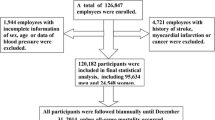Abstract
To explore the correlations of abnormal pulse pressure (PP) with the cardiovascular risk factors and cardiac functions by analyzing the distributions of abnormal PP in Han adults aged 18–74 years in Hebei, Zhejiang, and Guangxi province to provide evidence for health management. A cross-sectional study was carried out in three provinces of China. Multi-phase, stratified, unequal proportional and cluster sampling was adopted to investigate the data obtained from 12,795 Han adults aged 18–74 years. The prevalence of cases with abnormal PP in the three provinces was 6.7 %. Abnormal PP was significantly associated with a number of cardiovascular risk factors including location, age, gender, and education (P < 0.05). Results from multivariable logistic regression analysis showed that abnormal PP was positively associated with age and BMI. Compared with the normal subjects, there was a statistically significant difference in the mean of high-normal blood pressure, IFG divided by gender and LCW (P < 0.05). There was no significant difference in the mean of high-normal TC, TG, and LDL-C and low-normal HDL-C (P > 0.05). Age has also been found to be a statistically significant factor (P < 0.05). Abnormal PP was common in Chinese Han adults aged 18–74 years, which was independently associated with cardiovascular risk factors and cardiac functions. Health management for Han adults with abnormal PP was strongly suggested.

Similar content being viewed by others
References
Zheng, L. Q., Sun, Z. Q., Li, J., et al. (2008). Pulse pressure and mean arterial pressure in relation to ischemic stroke among patients with uncontrolled hypertension in rural areas of China. Stroke, 39(7), 1932–1937.
Writing Group of 2010 Chinese Guidelines for the Management of Hypertension. (2011). 2010 Chinese guidelines for the management of hypertension. Chinese Journal of Cardiology, 39(7), 579–616. (in Chinese).
Payam, K., Johan, S., & Franklin, S. S. (2012). Combined effects of brachial pulse pressure and sialic acid for risk of cardiovascular events during 40 years of follow-up in 37,843 individuals. Journal of Hypertension, 30(9), 1718–1724.
National Institute on Alcohol Abuse and Alcoholism. (2000). Health risks and benefits of alcohol consumption. Tenth Special Report to the US Congress on Alcohol and Health., 1, 5–11.
O’Brien, E., Petrie, J., Littler, W., et al. (1990). The British Hypertension Society protocol for the evaluation of automated and semi-automated blood pressure measuring devices with special reference to ambulatory systems. Journal of Hypertension, 8, 607–619.
Gordin, D., Waden, J., Forsblom, C., et al. (2011). Pulse pressure predicts incident cardiovascular disease but not diabetic nephropathy in patients with type 1 diabetes. Diabetes Care, 34(4), 886–891.
De, S., Giovanni, C., et al. (2006). High pulse pressure as a marker of preclinical cardiovascular disease. Future Cardiology, 2(2), 165–168.
Li, S., Xie, Z. H., Han, S. M., et al. (2011). Relation among abnormal pulse pressure and cardiovascular risk factors, cardiac function in Tibetan adults from Songpan county of Sichuan province in China. Chinese Journal of Integrative Medicine, 20(4), 293–296.
Weinberger, M. H., Fineberg, N.S., Fineberg, S. E., Weinberger, M. (2001). Salt sensitivity, pulse pressure, and death in normal and hypertensivehumans. Hypertension, 37(2 Pt 2), 429–432.
Jensky, N. E., Criqui, M. H., Wright, M. C., et al. (2010). Blood pressure and vascular calcification. Hypertension, 55(4), 990–997.
Mosley, W. J., Greenland, P., Garside, D. B., et al. (2007). Predictive utility of pulse pressure and other blood pressure measures for cardiovascular outcomes. Hypertension, 49(6), 1256–1264.
Schram, M., Chaturvedi, N., Fuller, J., et al. (2003). Pulse pressure is associated with age and cardiovascular disease in type 1 diabetes: The Epidemiology and Prevention of Diabetes Prospective Complications Study. Journal of Hypertension, 21(11), 2035–2044.
Zhang, L. Q., Chen, J., Zhu, Q. Q., et al. (2010). Central arterial pressure, brachial arterial pressure and pulse pressure in hypertensive patients. Chinese Journal of Evidence-Based Cardiovascular Medicine, 2(1), 34–36. (in Chinese).
Tropeano, A., Boutouyrie, P., Katsahian, S., et al. (2004). Glucose level is a major determinant of carotid intima-media thickness in patients with hypertension and hyperglycemia. Journal of Hypertension, 22(11), 2153–2160.
Li, H., Zhang, J., & Zhou, X. B. (2007). Relationship research on PP with body mass index, hyperglycemia and hyperlipidemia in elderly population in Guangzhou City. Guangdong Medicine, 28(9), 1509–1511. (in Chinese).
Author information
Authors and Affiliations
Corresponding author
Rights and permissions
About this article
Cite this article
Jiang, Z., Sang, H., Fu, X. et al. The Relations of Abnormal Pulse Pressure to the Cardiovascular Risk Factors and the Cardiac Function in Adults from Hebei, Zhejiang, and Guangxi Province of China. Cell Biochem Biophys 70, 1507–1511 (2014). https://doi.org/10.1007/s12013-014-0079-1
Published:
Issue Date:
DOI: https://doi.org/10.1007/s12013-014-0079-1




